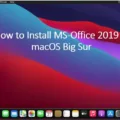Are you having trouble getting Zoom to work on your Mac? If so, we’ve got you covered! This guide will walk you through the process of uninstalling and reinstalling Zoom on Mac.
First, let’s go over how to uninstall Zoom from your Mac. To do this, open the Zoom application, click on the “Zoom” menu at the top, and select “Uninstall Zoom”. Confirm the deletion by clicking OK. Once this is done, all service files associated with Zoom will be removed from your computer.
Now that the app is deleted, it’s time to reinstall it. Do this by heading over to the Zoom download center and downloading and installing the appropriate version of Zoom for your Mac. Once downloaded and installed, open up the app and start a meeting with screen share to test if everything is working correctly.
Depending on your security settings, you may need to change them in order for apps downloaded from identified developers to be allowed onto your computer. If necessary, follow these instructions in order to do this:
1) Open System Preferences from the Apple menu or dock
2) Select Security & Privacy
3) Click on General
4) Select Allow apps downloaded from: identified developers
5) Confirm the selection by clicking Allow
6) You should now be able to install apps downloaded from identified developers
Once everything is installed and running correctly, you should be good to go! We hope this post has been helpful in getting you back up and running with Zoom on your Mac.

Troubleshooting Zoom Installation Issues on Mac
There are several possible reasons why Zoom may not be installed on your Mac. First, you may need to change your Security and Privacy settings to allow for apps downloaded from identified developers. To do this, open System Preferences, select Security & Privacy, then click the “Allow apps downloaded from” setting and select either “App Store and identified developers” or “Anywhere”.
Second, you may need to update your operating system (OS) in order to install the latest version of Zoom. To check if an update is available, open the App Store on your Mac and select Updates in the top menu bar. If an OS update is available, follow the steps provided by Apple to download and install it.
Third, you may need to temporarily disable any antivirus or anti-malware software that you have installed on your computer in order for Zoom to install correctly. Once the installation is complete, you can re-enable these programs.
If none of these steps resolve the issue, please contact Zoom Support at https://support.zoom.us/hc/en-us for additional assistance.
Troubleshooting Zoom App Issues on a Computer
If you are having trouble with the Zoom app on your computer, there are several steps you can take to try and fix the issue.
First, restart your computer. If the problem persists, check if the camera works in a Mac app such as Photo Booth or Facetime. If it works in these apps, you may need to uninstall and reinstall the Zoom client from our Download Center. To do this, start by uninstalling the existing version of Zoom from your computer. Once it has been removed from your computer, go to our Download Center (https://zoom.us/download) and select ‘Download’ for either Mac or PC (depending on what type of device you have). After downloading and installing the new version of Zoom, test it out to see if it works properly.
If these steps do not resolve your issue with Zoom on your computer, contact customer service for further assistance.
Troubleshooting Zoom App Installation Issues
There are a few possible reasons why your Zoom app isn’t installed. First, make sure you have enough space on your file system as the installation requires some storage. If you’re still having trouble, try downloading the latest version of Zoom directly from https://zoom.us/ instead of relying on 3rd-party sites. Additionally, try installing other software to make sure your device is compatible with the Zoom app. If you continue to experience issues, you may want to contact Zoom’s customer support or seek help from a computer technician.
Clearing Zoom Cache on a Mac
To clear your Zoom cache on a Mac, you’ll need to access the Zoom folder in your computer’s Library. To do this, click the Finder icon and select Go > Go to Folder from the menu bar at the top of the screen. In the pop-up window, enter /Library/Application Support/zoom.us and then double-click to open the Zoom folder. Once you have opened this folder, right-click on the data folder and select Move to Trash. This will delete all of the files stored in your Zoom cache.
Conclusion
In conclusion, uninstalling and reinstalling Zoom on a Mac involves changing the Security and Privacy settings to allow for apps from identified developers, launching the Zoom application, selecting the Uninstall option, and confirming the deletion. After that, you can then download and install the appropriate Zoom client for meetings and test to see if any issues persist. Following this process should ensure that you have a successful installation of Zoom on your Mac computer.








